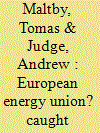|
|
|
Sort Order |
|
|
|
Items / Page
|
|
|
|
|
|
|
| Srl | Item |
| 1 |
ID:
153503


|
|
|
|
|
| Summary/Abstract |
Fears about the security of supplies have been central to debates about the development of an integrated EU energy policy over the past decade, leading to claims that energy has been ‘securitised’. Previous analyses have found, however, that although shared security concerns are frequently used as justification for further integration, they can also serve as a rationale for Member States to resist sharing sovereignty. Transcending this apparent paradox would require not just agreement about whether energy supplies are security concerns, but also agreement about what kind of security concern they are. In this article, we examine whether such an agreement could emerge through a comparative analysis of constructions of gas security in the UK and Poland. Utilising a framework that draws from both the philosophical and sociological wings of Securitisation Studies, we demonstrate that although gas has been elevated on the security agendas of both states, the specific logic of insecurity – securitisation or riskification – underpinning these constructions differs substantially, and is conditioned by distinct modes of governance in each Member State. This, we contend, limits the potential for further integration of EU energy policies in the context of the European Commission’s proposals for an ‘Energy Union’.
|
|
|
|
|
|
|
|
|
|
|
|
|
|
|
|
| 2 |
ID:
190060


|
|
|
|
|
| Summary/Abstract |
In a relatively short time, cybersecurity has risen to become one of the EU’s security priorities. While the institutionalisation of EU-level cybersecurity capacities has been substantial since the first EU cybersecurity strategy was published, previous research has also identified resistance from member states to allow the EU to have more control over their cybersecurity activities. Despite a growing literature on EU cybersecurity governance, there are currently extensive gaps in the understanding of this tension. This study suggests that an explanatory factor can be found in the so-far overlooked dynamic of the relative prevalence of risk vs. threat-based security logics in the EU cybersecurity approach. By distinguishing between risk and threat-based logics in the development of the EU cybersecurity discourse over time, this study highlights a shift towards an increasing threat-based security logic in the EU cybersecurity approach. The identified development highlights securitising moves enacting to a larger extent than before objects and subjects of security traditionally associated with national security. The study identifies specific areas of member state contestation accompanying this shift and concludes with a discussion on the findings in relation to the development of the EU as a security actor in the wider international cybersecurity landscape.
|
|
|
|
|
|
|
|
|
|
|
|
|
|
|
|
| 3 |
ID:
192166


|
|
|
|
|
| Summary/Abstract |
This essay unpacks the hedging behavior of small and secondary states by focusing on Southeast Asian responses to the intense US-China rivalry and the emergence of the Quadrilateral Security Dialogue (Quad) in the Indo-Pacific region. It contends that the weaker states’ perceptions of external realities are not black and white, but shades of grey, as uncertainty breeds ambiguity and ambivalence. The states often do not view a major power (and its initiatives) as either a clear-cut threat or a straightforward solution. Instead, they perceive a spectrum of risks and challenges, each with constantly changing manifestations and magnitude, all of which require complex combinations of mutually-reinforcing and counteracting measures. All ASEAN states have mixed attitudes towards the competing powers, viewing both the Quad’s Free and Open Indo-Pacific (FOIP) strategies and China’s Belt and Road Initiative (BRI) as bringing not only opportunities but also risks and dangers. These ambivalent perceptions entail a process of ‘riskification’, where states identify and prioritize certain risks while downplaying others, in ways that serve elite interests at home. Hence, while nearly all the ASEAN states have stressed in varying degrees the risks of entrapment, abandonment, polarization and marginalization, many have downplayed the dangers of big-power aggressiveness and interference, some more so than others. The varying riskification patterns thus lead to varying hedging acts, prompting subtly different responses to the emerging realities.
|
|
|
|
|
|
|
|
|
|
|
|
|
|
|
|
|
|
|
|
|